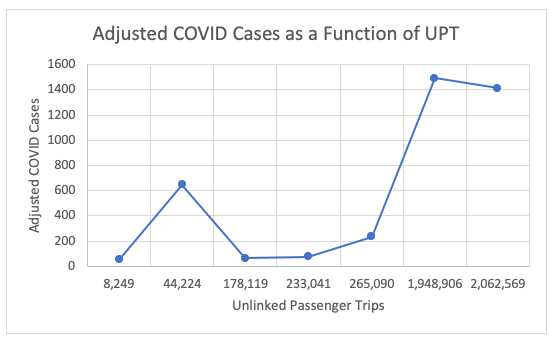An MIT study on the factors that contributed to the transmission of COVID-19 has gotten a lot of traction recently. Dominic Coletti, research intern at the John Locke Foundation, wrote a research brief this week examining the report and explaining what it could mean for North Carolina. Coletti writes:
A working paper published by MIT economist Jeffrey Harris argues that the subway was responsible for the outbreak in New York City…
North Carolina’s largest cities do not have extensive subway networks, but many do have well-developed systems of public transportation. How does the Harris hypothesis fare outside of New York City? Is there a consistent relationship between public transit ridership and COVID-19 cases in North Carolina cities?
Coletti examined seven metropolitan areas in North Carolina who report unlinked passenger trips (UPT) to the Federal Transit Administration to see if more public transportation trips had any connection to COVID-19 cases in North Carolina. Coletti writes:
The Research Triangle and the Charlotte area saw the most unlinked passenger trips (2,062,569 and 1,948,906, respectively) and the most COVID cases (1,413 and 1,494, respectively), while Hickory saw the fewest of both (8,249 and 54).
This trend holds with one notable exception: the Triad. Greensboro, High Point, and Winston-Salem have disproportionately low public transit ridership for their size (44,224). However, the COVID-19 cases there (648), while fewer than would be expected for the region’s population, are significantly higher than the expected value based on their transit ridership.

This research suggests the relationship between public transportation and coronavirus in North Carolina is no smoking gun. As Coletti puts it:
Cities with a higher public transit ridership likely will have higher infection rates, but it’s not known if public transportation use is the cause of transmission. For example, land use patterns and population density may create both a higher risk for COVID-19 and high public transit ridership…
Is there a relationship between public transit ridership and coronavirus-related deaths in a given city? Infections do not correlate to the number of deaths, so the answer appears to be no. Other factors may actually predict mortality rate, most likely indicators of the city’s overall health.
Read the full brief here. Read about a recent audit that uncovered the NC Department of Transportation went $742 million over its budget in Carolina Journal here.


